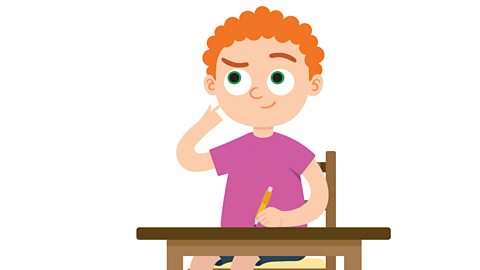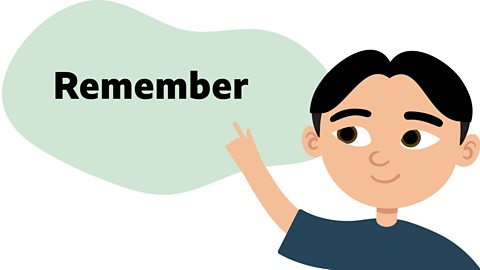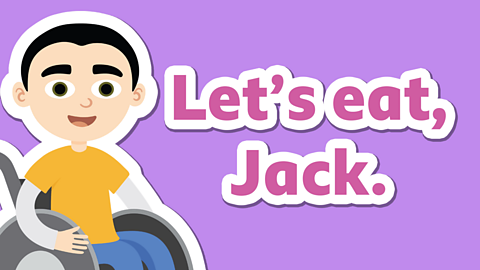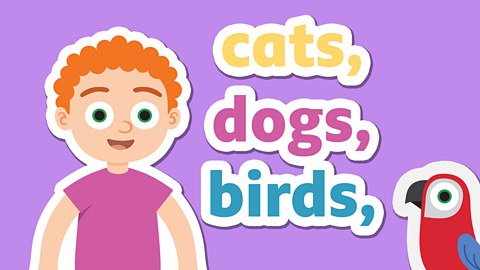Why do you need punctuation?

Punctuation is very important in our writing. Without it, writing would just be a mess of letters and words and we wouldn’t be able to breathe when reading!
Full stops are needed at the end of most sentences. They tell the reader to pause, take a breath and move onto the next sentence. They show us how information is broken up.
But sentences don’t always end in full stops. They could end in a question mark or an exclamation mark.

Watch: Full stops
Full stops always go at the end of a sentence:
- 'I love tennis.'
- 'I love rugby.'
- 'I love lots of other sports.'
What are full stops and commas? How and why would you use them?
Full stops and commas.
Full stops and commas are punctuation marks.
A full stop ends a sentence.
A comma shows a pause, breaks up a list or separates parts of a sentence.
Full stops are easy. They always go at the end of a sentence.
I love tennis.
I love rugby.
In fact, I love lots of sports.
But I’m not so keen on football.
A comma could be used to link these sentences and form a list.
I love tennis, rugby, and lots of other sports, but not football.
Be careful though! Commas can completely change the meaning of a sentence.
“Let’s eat, Lucy!” means you are inviting Lucy to eat.
“Let’s eat Lucy!” means you are about to eat Lucy for dinner!
If you aren’t sure where to put a comma, try reading the sentence out loud.
A comma is where you tend to pause for breath, before continuing.
In her poem Originally, Carol Anne Duffy uses full stops and commas to emphasise that growing up is about change.
“All childhood is an emigration. Some are slow, leaving you standing, resigned, up an avenue where no one you know stays. Others are sudden.”
The short sentences at the beginning and end of this passage cause impact, and the list in between reinforces the points that the short sentences are making.
The structure of the sentences also reflects the point being made.
“Others are sudden” is short and sharp, whereas the middle sentence is slow and long, emphasising the time taken for some changes to take place.
Once you get your head round full stops and commas, there will be no stopping you.
Sentences

Full stops can be used to create different sentence lengths and types. These can can have different effects on the the reader.
- Longer sentences may be used for a more detailed description or an explanation.
- Shorter sentences may be used to have impact, reflect the point that is being made or build up tension: 'She stopped suddenly.'

Commas
Commas can be used to:
- create a list
- show a pause
- break up a long sentence into smaller chunks
Lists
Lists can connect lots of related items or topics using commas: 'I love tennis, rugby and lots of other sports.'
If a list is present, look at the order in which the points are listed. If they lead up to the most important item at the end, there is a build-up to a climax: 'Jessica wanted to pass her exams, go to University and become a doctor.'
Pauses
Be careful! Commas can completely changed the meaning of a sentence.
- 'Let's eat, Lucy.' means you are inviting Lucy to eat.
- 'Let's eat Lucy.' means you are about to eat Lucy!
If you're not sure where to put a comma, try reading the sentence out loud. A comma is often where you would pause for a breath before continuing.
Breaking up longer sentences
In a long sentence, you can use commas to separate out extra information and make the sentence easier to read.
A clause is the building block for a sentence. Commas can be used to break up sentences that have more than one clause and make them easier to read.
- 'When Josh saw the food, his stomach started to grumble.'
- 'Josh used to stay up late playing video games, but then his mum found out.'
Both these sentences have a subordinate clause. Subordinate clauses do not make sense on their own. These clauses need the main part of the sentence to make sense, so they are connected with a comma. The comma shows that they are closely connected to the main part of the sentence.
Watch: Question marks
Find out when and where to use question marks in your writing
As shown in the video, a question mark goes on the end of every question. It shows the reader a question is being asked.
Questions often start with who, what, where, when or why.
Watch: Using exclamation marks
Exclamation marks are another type of punctuation that can go at the end of sentences.
Watch this clip to learn more about them.
An exclamation mark shows its use by surprising words and giving them emotion
As shown in the clip, an exclamation mark is used to show surprise, force, excitement or anger.
It helps make the meaning of the sentence clear for the reader and helps them to understand what characters are feeling.
Activity 1
Complete these two interactive activities.
- Select the words that should end with a question mark.
Activity 2
Highlight where an exclamation mark should go.
Activity 3
Write each sentence out on paper and add a full stop, question mark or exclamation mark to the end of each one.
- I went to the park to play on the swings
- I love going to the zoo
- Why is it is so hot
- What are you doing for your birthday party
- Katy skipped down the road
- I hate it when it rains
When you have finished you can check your answers with this answer sheet.

- Full stops go at the end of sentences.
- Question marks go at the end of questions.
- Exclamation marks show surprise, force or anger.

Activity 4
Choose your favourite character from a book, TV show or film.
- Write two sentences about that character, each ending in a full stop.
- Write two questions you wish you could ask that character.
- Write two sentences using an exclamation mark that a character might say.
Play Crystal Explorers to get ready for SATs. gamePlay Crystal Explorers to get ready for SATs
In this game, use grammar, punctuation and spelling skills to explore jungles, caves and tombs on your mission!

More on Punctuation
Find out more by working through a topic
- count2 of 12

- count3 of 12

- count4 of 12

- count5 of 12
